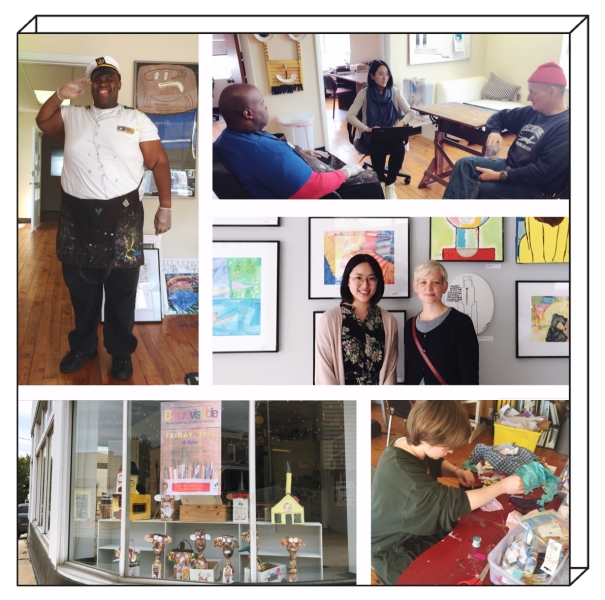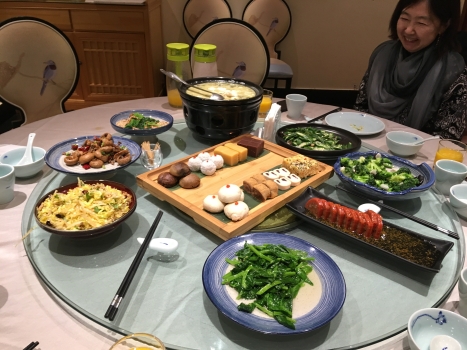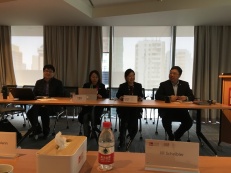by Jill
Make Studio’s staff members don’t often contribute to this blog because it’s primarily a place for our artists to share their faves and reflections, but I’m making an exception (a small series of them). It seemed like the best way to share highlights of my recent visit to China, on behalf of Make Studio and the National Committee on U.S.-China Relations (NCUSCR), with our Make Studio family.
(This, the first post in a 3-part series, will be the wordiest one of the three. So please hang in there for parts 2 and 3, if fascinating photos are what you’re looking for!)
You might recall that we were excited to host Zhu Xin (English name, Julia) from World of Art Brut Culture (WABC) as a NCUSCR Chinese Fellow for almost a month last fall.

Photo collage of Julia’s time at Make Studio, provided by Julia.
U.S. host organizations can apply to NCUSCR to send a representative to China in a reciprocal exchange. We did, and we were honored that Make Studio was selected amongst several other, much larger organizations to participate. A few months and a lot of preparations later, and I found myself on the 13-hour flight to Beijing!
Once in Beijing, a group of the NCUSCR U.S. Fellows (excepting 2 who traveled on to Mongolia, and 1 who had to come later) received informal and formal orientations. We started with a crash course in avoiding oncoming traffic (cars, scooters, and bikes; pun intended), hailing local taxis, and “Peking-style” dining at a welcome dinner hosted for us by Irene Bao of the China Global Philanthropy Institute (CGPI).

Family-style dinner at a popular Beijing restaurant.
On our first full day in Beijing, we received an introduction to the current context for philanthropy, volunteerism, and NGOs/nonprofits in China, with a presentation from CGPI’s Vice President, Huang Haoming and a Q&A with their staff.
CGPI was founded by several philanthropists — five from China and two from the U.S. (Bill Gates and Ray Dali) — and is committed to building a knowledge system supporting the development of philanthropy for social good in China and throughout the world.

Spotted in the CGPI lobby: Bill Gate’s favorite books. Who knew?
We quickly learned that organizations in China face similar challenges to those in the U.S. — such as funding, volunteer engagement, and heavy workloads — but also deal with very different issues because “nonprofits” and “volunteerism”, as we think of them, are much newer concepts in China. There are also new laws that sharply constrain NGO’s activities.
Our understanding of these issues was then furthered by two on-site visits with staff at Beijing-based NGOs, arranged by CGPI. It turned out that I was the lucky one in our group, because both visits were highly relevant to Make Studio!

Artwork being prepped for exhibit at WABC Beijing.
The first site was WABC’s Beijing studio — giving me a sneak peek at program operations that I would later learn a lot more about at WABC’s Shanghai studio.

As a contrarian and an art therapist, I drew my dog “picking” an apple.
The whole group, however, enjoyed learning about WABC’s mission, their recent, massively successfully fundraising campaign, and experiencing an activity based on the Person Picking an Apple from a Tree (PPAT) assessment, quite familiar to American art therapists, led by a WABC art teacher.
After another decadent, traditional Beijing meal, we proceeded to our second site visit at Sany Foundation’s incubator hub. Towards their interest in “promoting scientific philanthropy”, similarly to a trending interest in non- and for profit incubation (with similar pros and cons that come with this concept), Sany Foundation incubates innovative projects in the interest of public welfare by providing them start-up funds, workspace, and other supports.
We were given a warm welcome and an informative introduction by Ying Li, Senior Program Director, in which she described how Sany’s incubator is a start-up itself and like a lot of young organizations it is working to firm up its mission, vision, and values. (These will have to remain a mystery for our non-Chinese readers and those who do not wish to take the time to translate.)
Next, the entire group was enthralled by the presentation given by Wu Di, Program Director and Co-Founder of Easy Inclusion, a social enterprise that provides disability inclusion trainings and strategies to companies to practice and benefit from inclusion.

Wu Di describes concerns of an uninformed administrator leery of hiring people with disabilities.
From Wu Di we learned about historical, problematic Chinese views on disability, which are not very different from ones we contend with in the U.S. But, also, how China’s policies regarding the employment of people with disabilities are radically different from the U.S.’s to both good and bad effect.
From both presentations, we all came away with a lot of food for thought about how policies shape our own programs, and how we can be more innovative in our approaches.

Pictured (l to r, starting top left): Heather McCann of Groundwork Lawrence, Jessica Ristich of St. Francis Community Services, Mary DeWitt-Dia of American Red Cross, Margot Landman of NCUSCR, CGPI host and intern (regrettably, names missing), Wu Di, Ying Li, and me.
Although our orientation in Beijing was brief, it provided me with loads of context to help me better understand what I’d go on to see and learn during the next leg of my trip in Shanghai.
Please stay tuned for Parts 2 and 3 of this series, coming soon, where I’ll share many images, and much fewer jet lagged words, from WABC Shanghai!





Pingback: Make Studio Goes to China! Part 2 | faves saved·